Over the past several years, there has been extensive coverage on the phasing out of third-party cookies and its implications for the advertising industry. Marketers are grappling with the question of how to maintain their advertising strategies in a post-cookie world. Previously, Semetis wrote an article on practical alternatives to address this significant shift.
However, it is important to note that the implications of the disappearance of cookies go beyond the efficacy of marketing campaigns. Not only will targeting options and audience data slowly become less and less accurate, measurement will also be affected. It will become increasingly more difficult to measure the impact of your marketing efforts, as users opt out of cookies. One of the solutions that has been put forward is Marketing Mix Modeling.
How is MMM used to analyze your marketing efforts?
Marketing Mix Modeling (MMM) is a statistical methodology that is used to evaluate the impact of various marketing strategies and tactics on a business’s sales and revenue. It helps companies determine the optimal allocation of resources across various channels and activities to maximize the return on investment from their marketing efforts. MMM is a critical tool for organizations that aim to measure and optimize the effectiveness of their marketing spend and improve their marketing performance.
Marketing Mix Modeling is not new. It is a technique that has been used extensively to analyse the impact of offline marketing on sales and to explain the incremental sales due to marketing efforts. It was used mainly at the end of the 20th century and the beginning of the 21st century, but with the rise of web analytics and attribution models it has been referred to the recycling bin by digital marketers. Today, due to the combination of online and offline data, the exponential increase of computing power, cloud-based technologies and more advanced and re-usable AI models that help accelerate the frequency of delivery of insights, MMM is becoming increasingly relevant.
Marketing Mix Modeling can be used to answer several important business questions, including:
- How does the marketing mix affect sales and revenue over time?
- How does each media channel contribute to the total revenue in the absence of attribution modeling?
- What is the optimal budget division between marketing channels to reach a desired level of sales and revenue?
- How do changes in the marketing mix affect sales and revenue, and by how much?
- What is the impact of external factors on my total revenue?
- Which channels in my media mix are saturated? Where can I invest more, and where should I invest less? An example of a channels saturation breakdown can be found in the graph below.
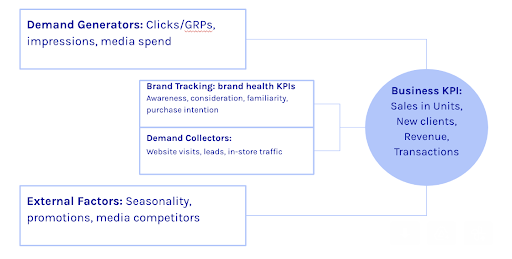
The visual below provides a typical outcome of an MMM analysis. It provides a representation of the decomposition of the revenue by all media channels. The base revenue (black bar) in marketing mix modeling is typically considered as the revenue that a company would have earned in the absence of any marketing efforts.
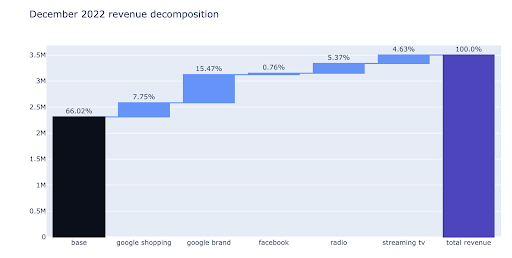
From Media to Marketing Mix Modeling
Igor Skokan, Marketing Science Director at Meta, refers to MMM as Marketing Mix Modeling, rather than Media Mix Modeling: “We also sometimes refer to this as a marketing mix modeling, not just media mix, because MMM itself actually is much more powerful … it’s more like holistic business modeling, so it goes way beyond media, even way beyond marketing into business drivers, price, distribution, other things, even whether all kinds of things that impact business … should be included in the modeling.”
In practice, MMM models take external factors into consideration. These are variables that may influence the relationship between the marketing mix and sales. For example, in the retail industry, the economy and consumer confidence are external factors that may impact sales and revenue. MMM models take these variables into account to get a complete and accurate picture of the impact of the marketing mix on the business.
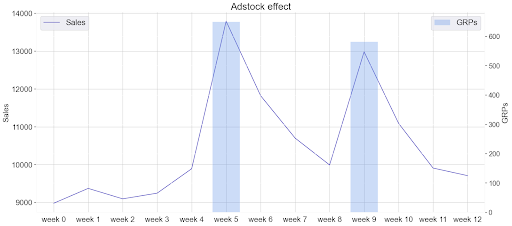
Added into our visual in the introduction, our base revenue will then be broken down into the effect of several external factors, like online promotions, in-store promotions, and even weather precipitations.
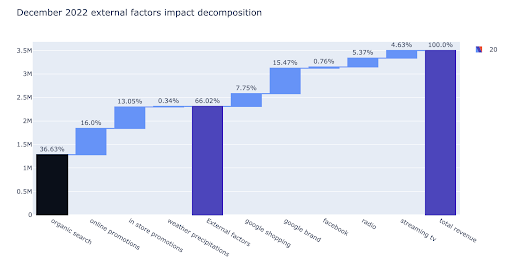
The predictive power of MMM
Next to performing insighful analysis, Marketing Mix Modeling is also known for its predictive power, which refers to its ability to recommend an optimized budget spend based on the historical data and the marketing mix, and predict the effect on sales. By analyzing the historical data and the impact of the marketing mix on sales, the model is able to forecast future sales and revenue based on changes to the marketing mix.
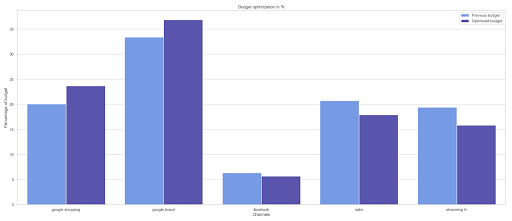
In conclusion, Marketing Mix Modeling is a critical tool for organizations looking to improve the effectiveness of their marketing efforts and maximize the return on investment from their marketing spend. By analyzing the historical data related to the four key elements of the marketing mix and their impact on sales and revenue, companies can make informed decisions about their marketing strategy and achieve their desired marketing outcomes.
Want to get started with Marketing Mix Modeling? Contact This email address is being protected from spambots. You need JavaScript enabled to view it. to kick off your route to measurement excellence!



